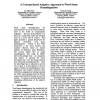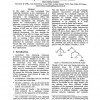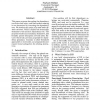ACL
1998
14 years 26 days ago
1998
Word sense disambiguation for unrestricted text is one of the most difficult tasks in the fields of computational linguistics. The crux of the problem is to discover a model that ...
ACL
1998
14 years 26 days ago
1998
The paper presents a language model that develops syntactic structure and uses it to extract meaningful information from the word history, thus enabling the use of long distance d...
ACL
1998
14 years 26 days ago
1998
Finding simple, non-recursive, base noun phrases is an important subtask for many natural language processing applications. While previous empirical methods for base NP identifica...
ACL
1998
14 years 26 days ago
1998
In this paper we view Lexicalized Tree Adjoining Grammars as the compilation of a tract and modular layer of linguistic description :the metagrammar (MG). MG provides a hierarchic...
ACL
1998
14 years 26 days ago
1998
The centering framework explains local coherence by relating local focus and the form of referring expressions. It has proven useful in monolog, but its utility for multiparty dis...
ACL
1998
14 years 26 days ago
1998
This study exploits statistical redundancy inherent in natural language to automatically predict scores for essays. We use a hybrid feature identification method, including syntac...
ACL
1998
14 years 26 days ago
1998
This paper describes a new scoring algorithm that supports comparison of linguistically annotated data from noisy sources. The new algorithm generalizes the Message Understanding ...
ACL
1998
14 years 26 days ago
1998
This paper presents a technique to deal with multiword nominal terminology in a computational Lexical Functional Grammar. This method treats multiword terms as single tokens by mo...
ACL
1998
14 years 26 days ago
1998
This paper proposes decoupling the dependency tree from word order, such that surface ordering is not determined by traversing the dependency tree. We develop the notion of a word...
ACL
1998
14 years 26 days ago
1998
One of the most exciting recent directions in machine learning is the discovery that the combination of multiple classifiers often results in significantly better performance than...



